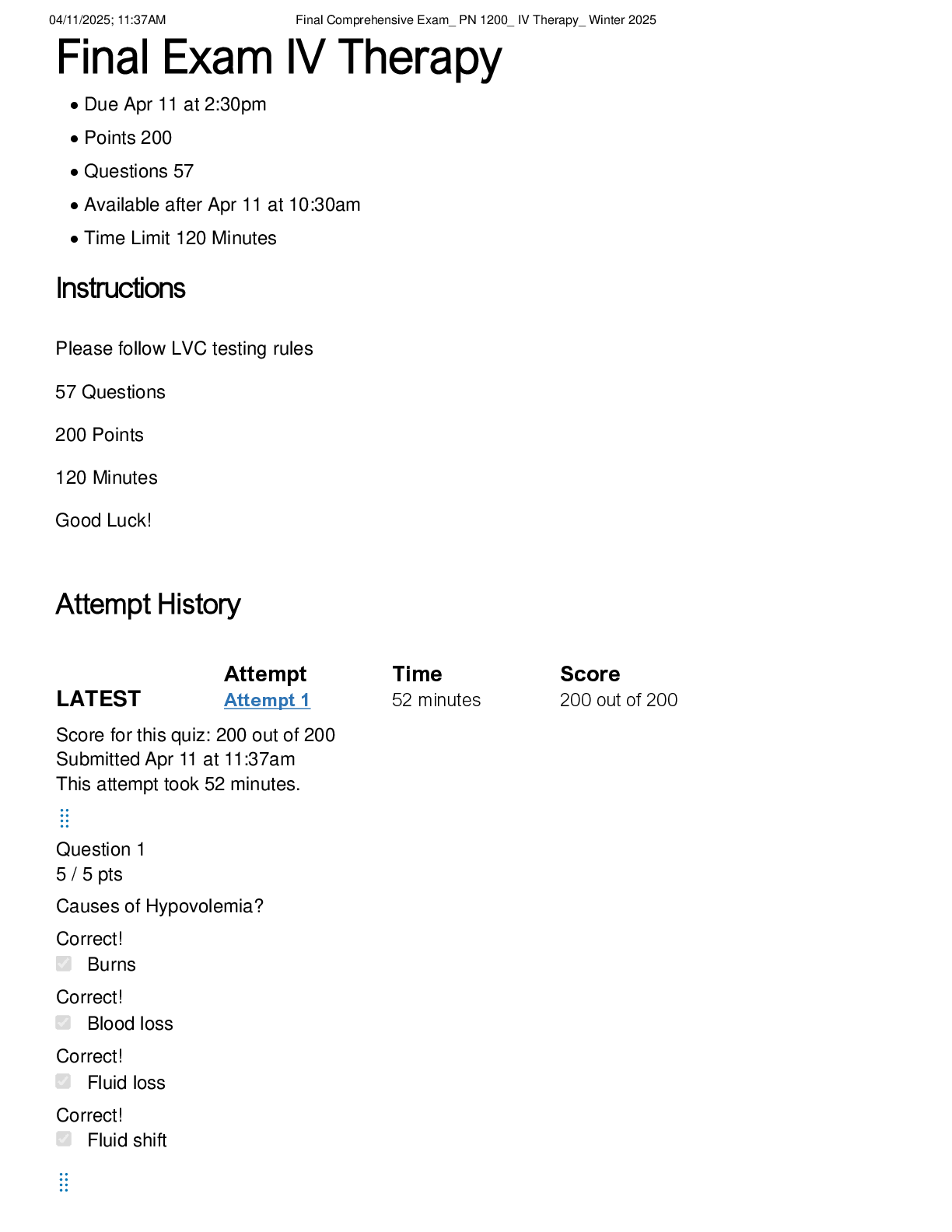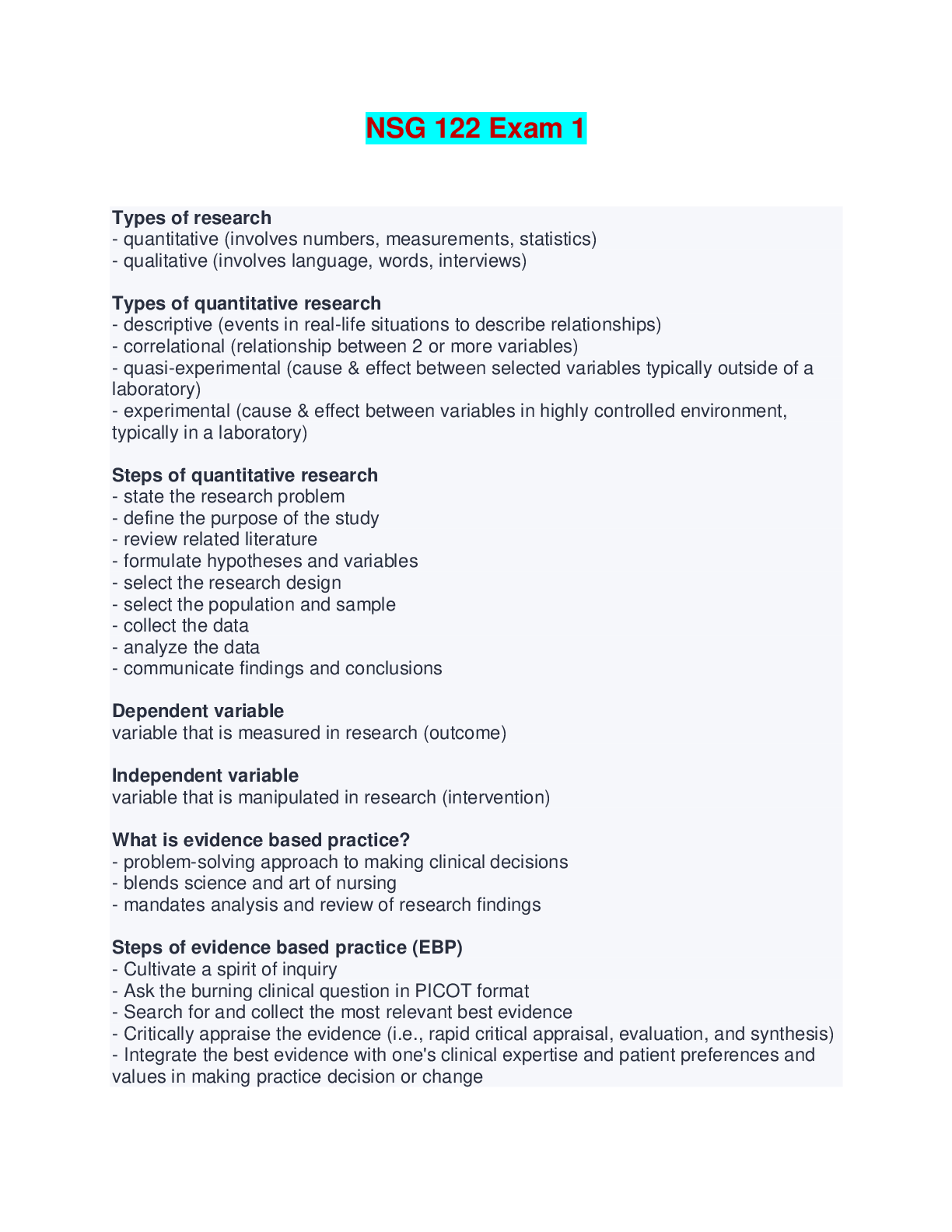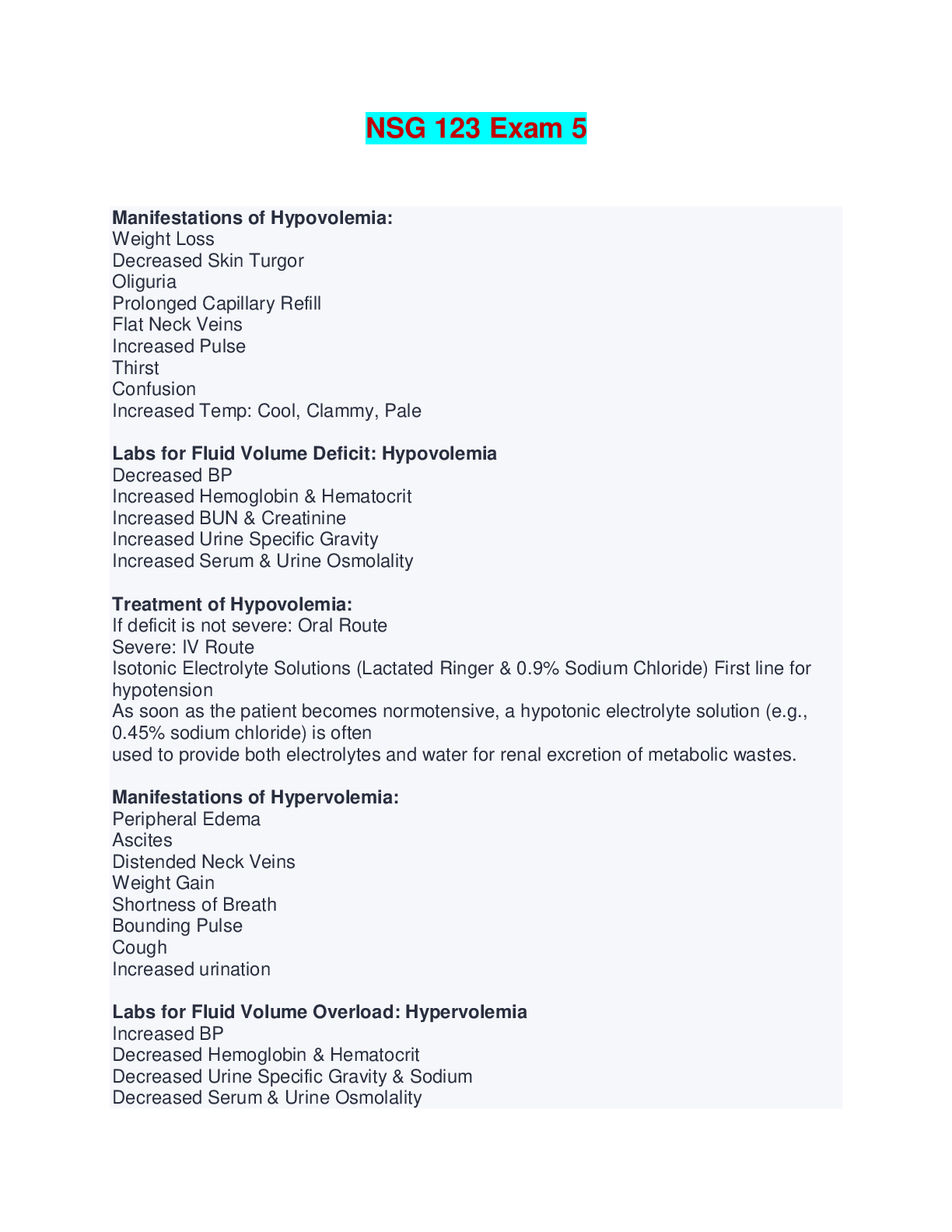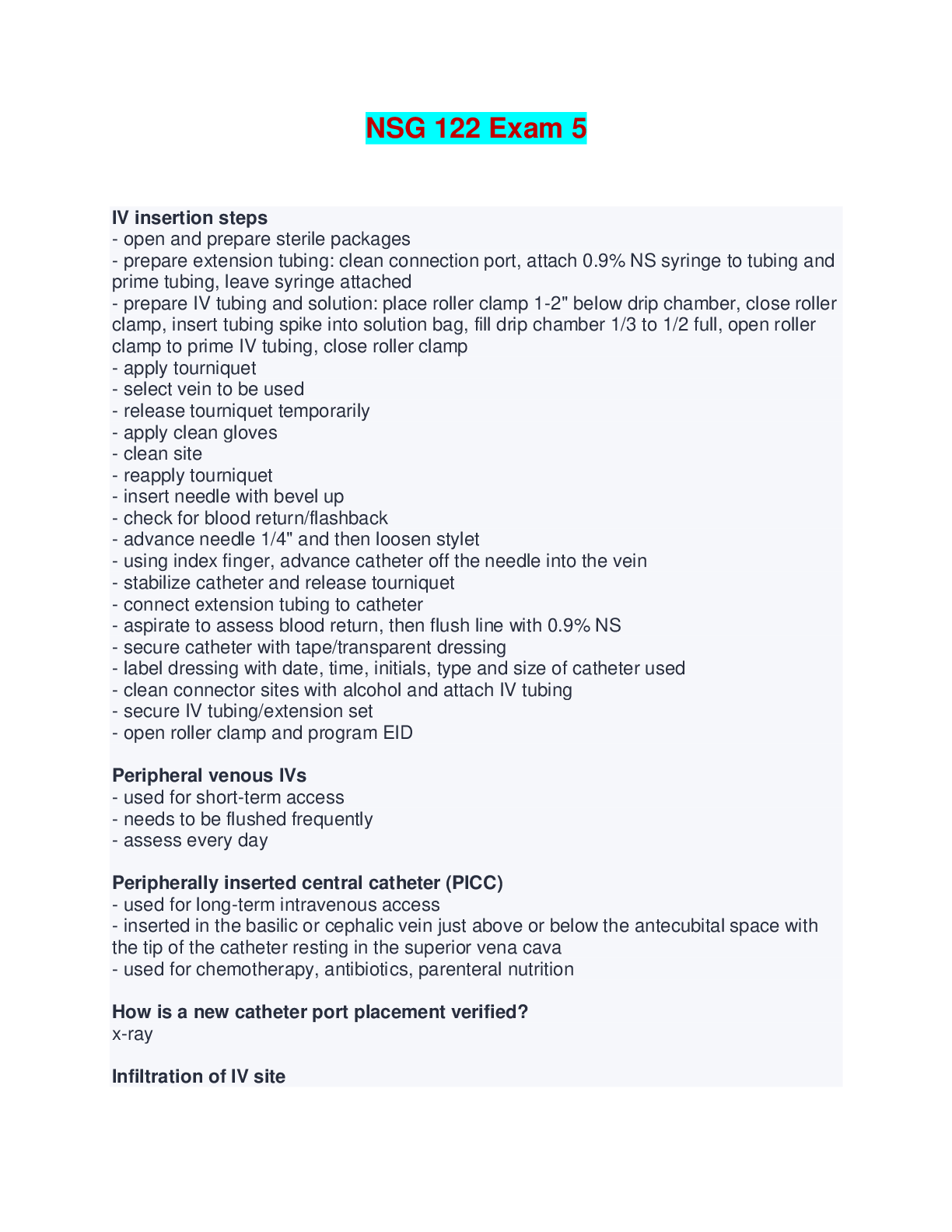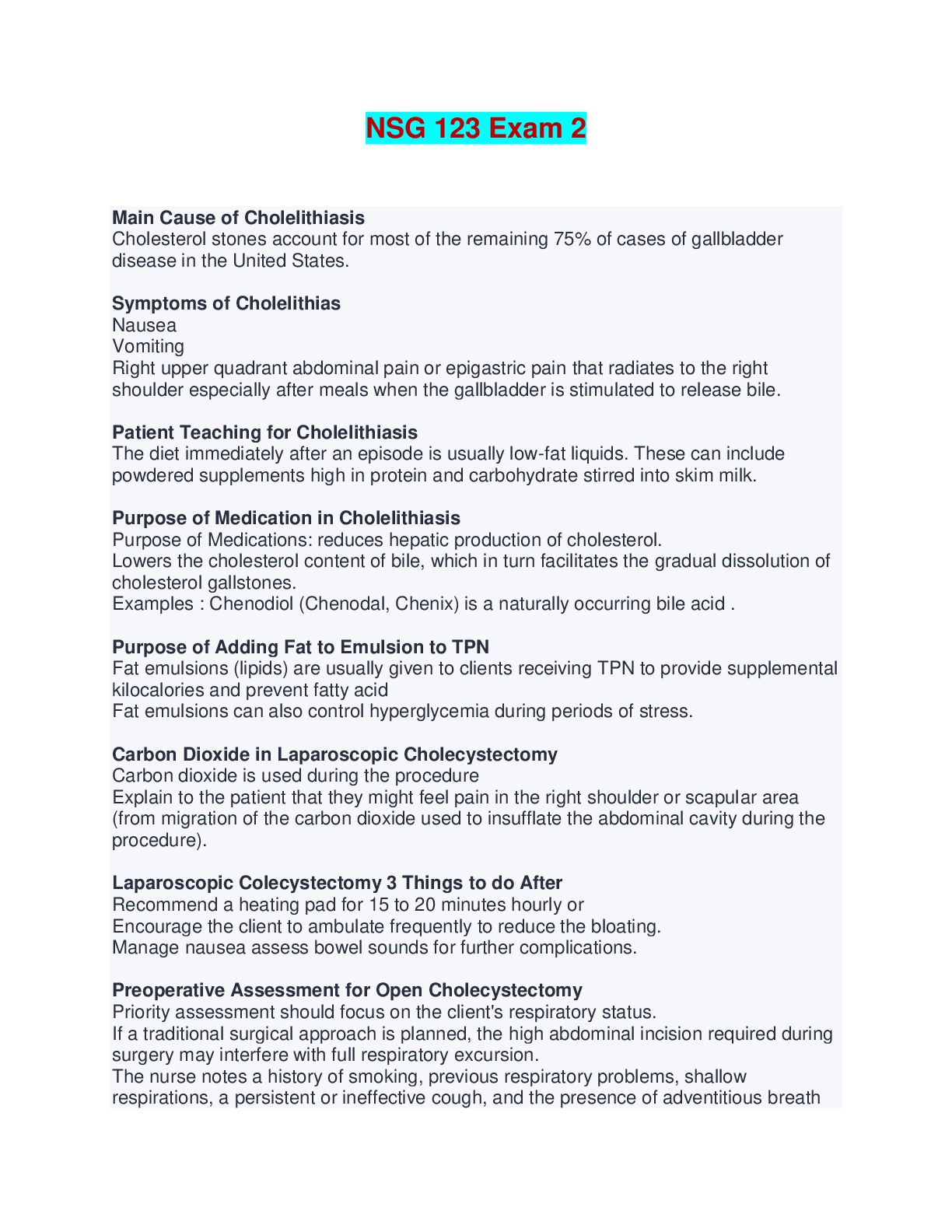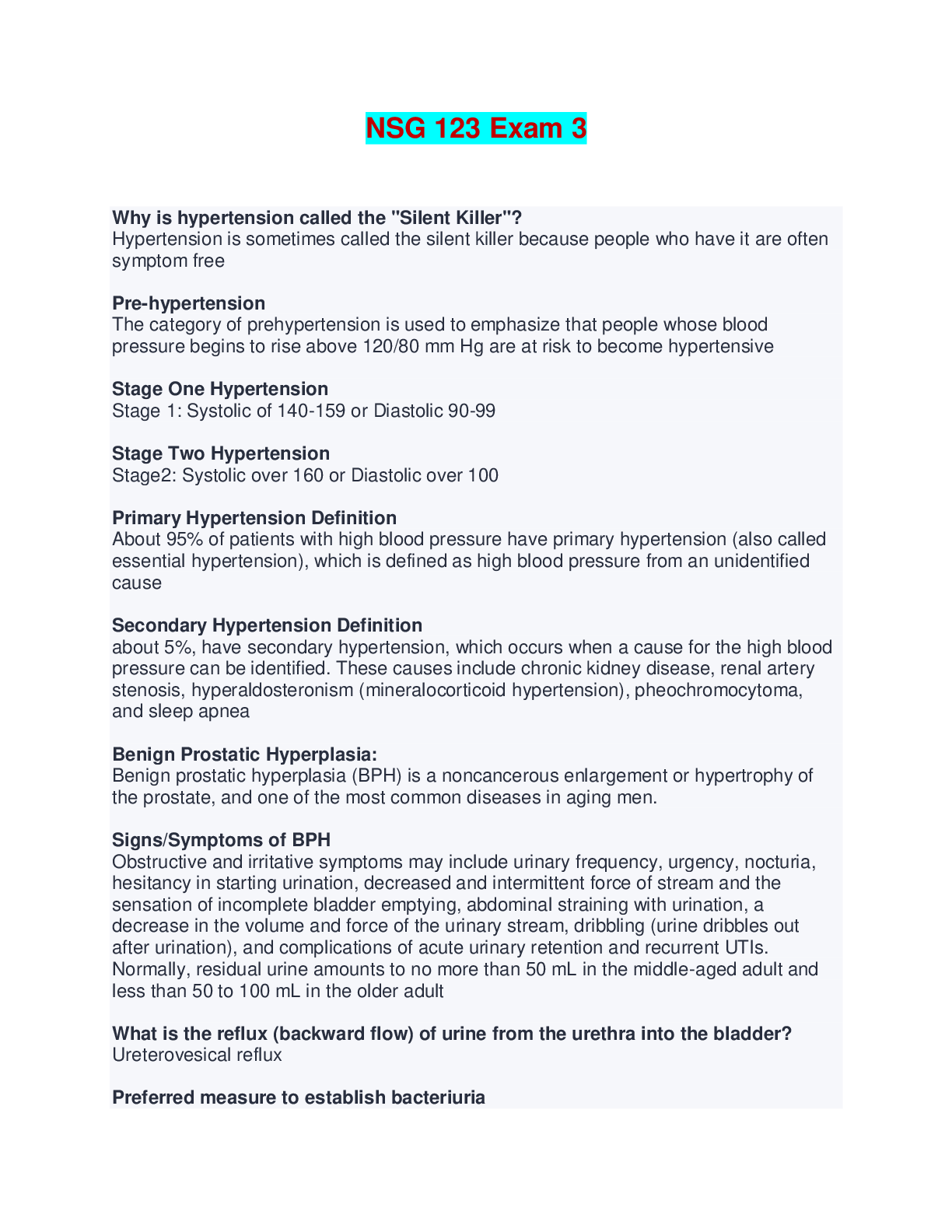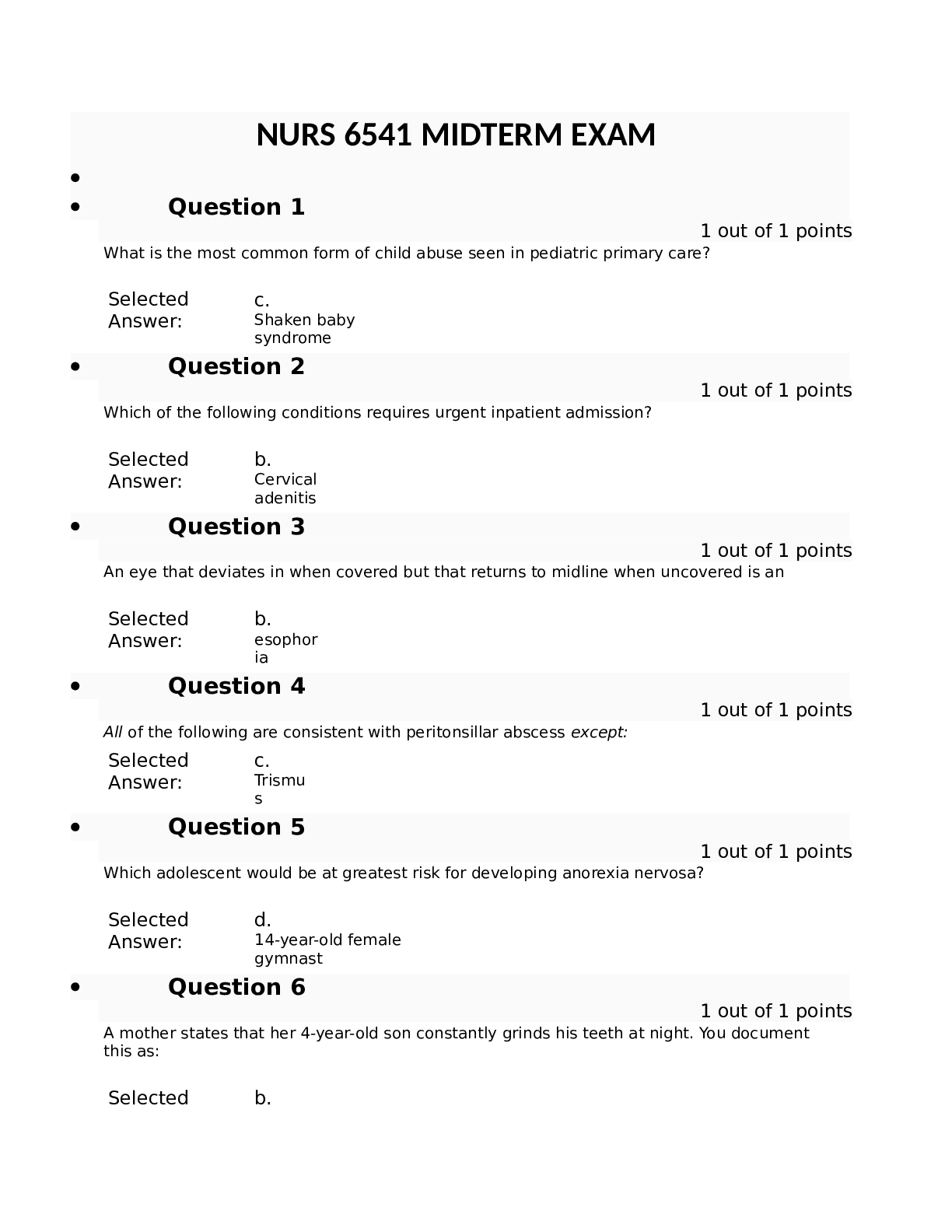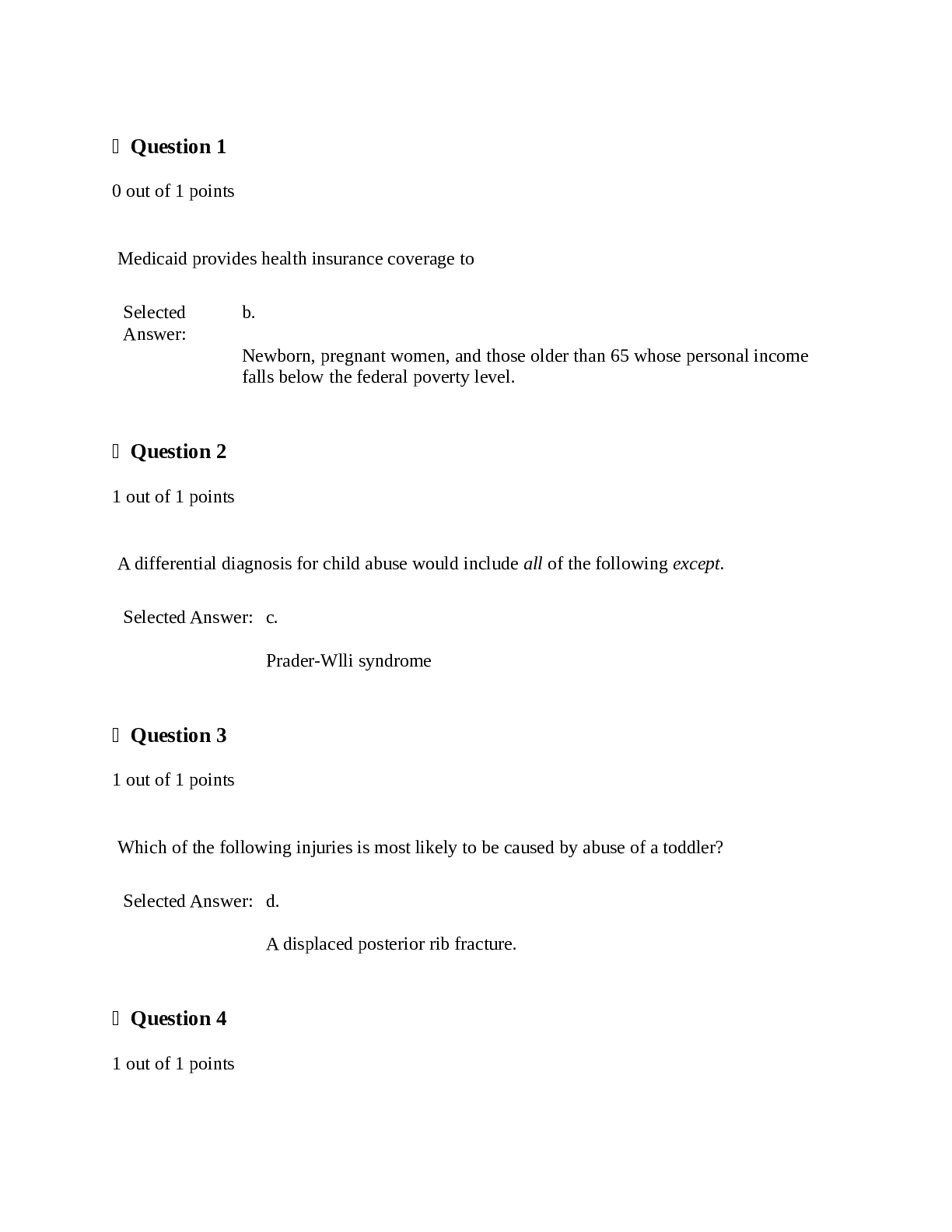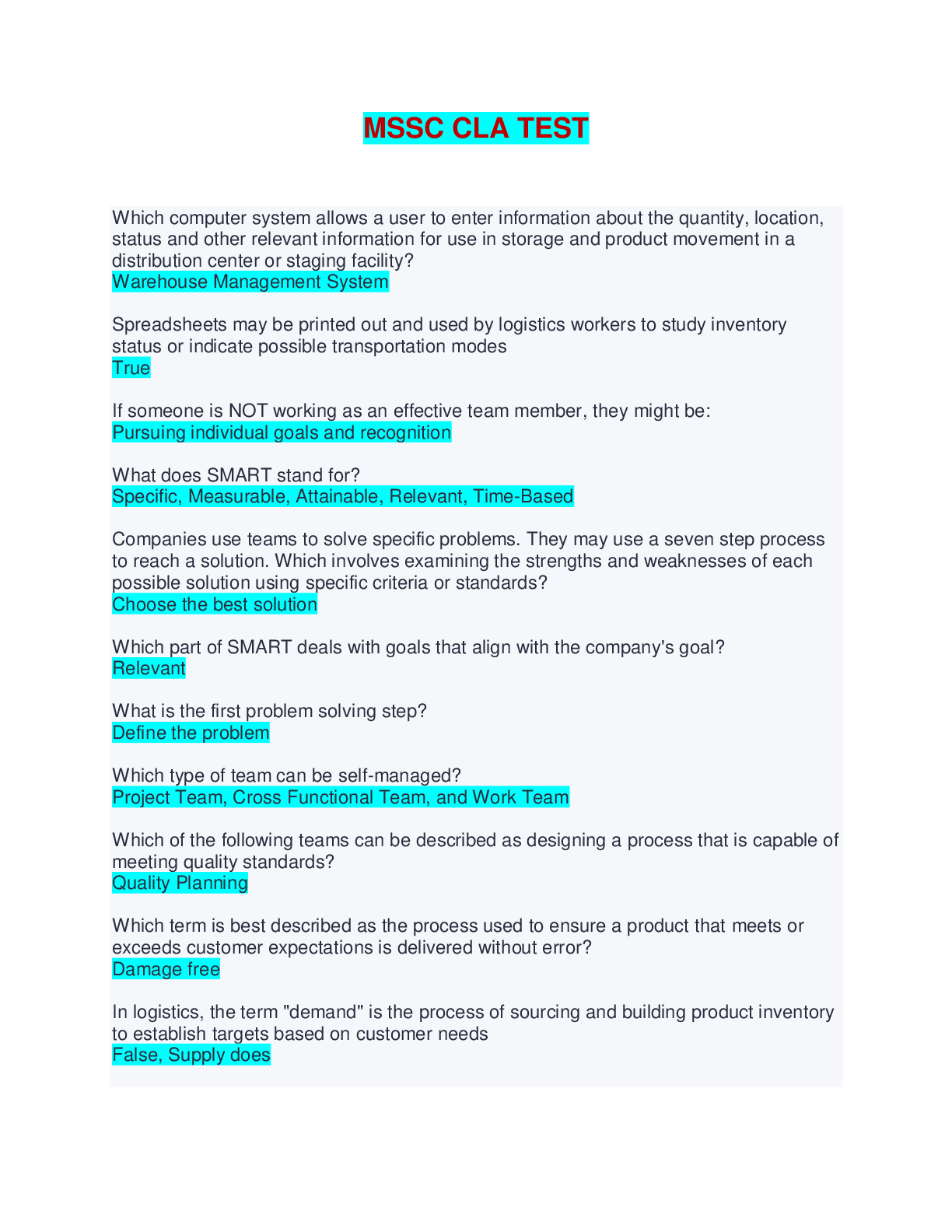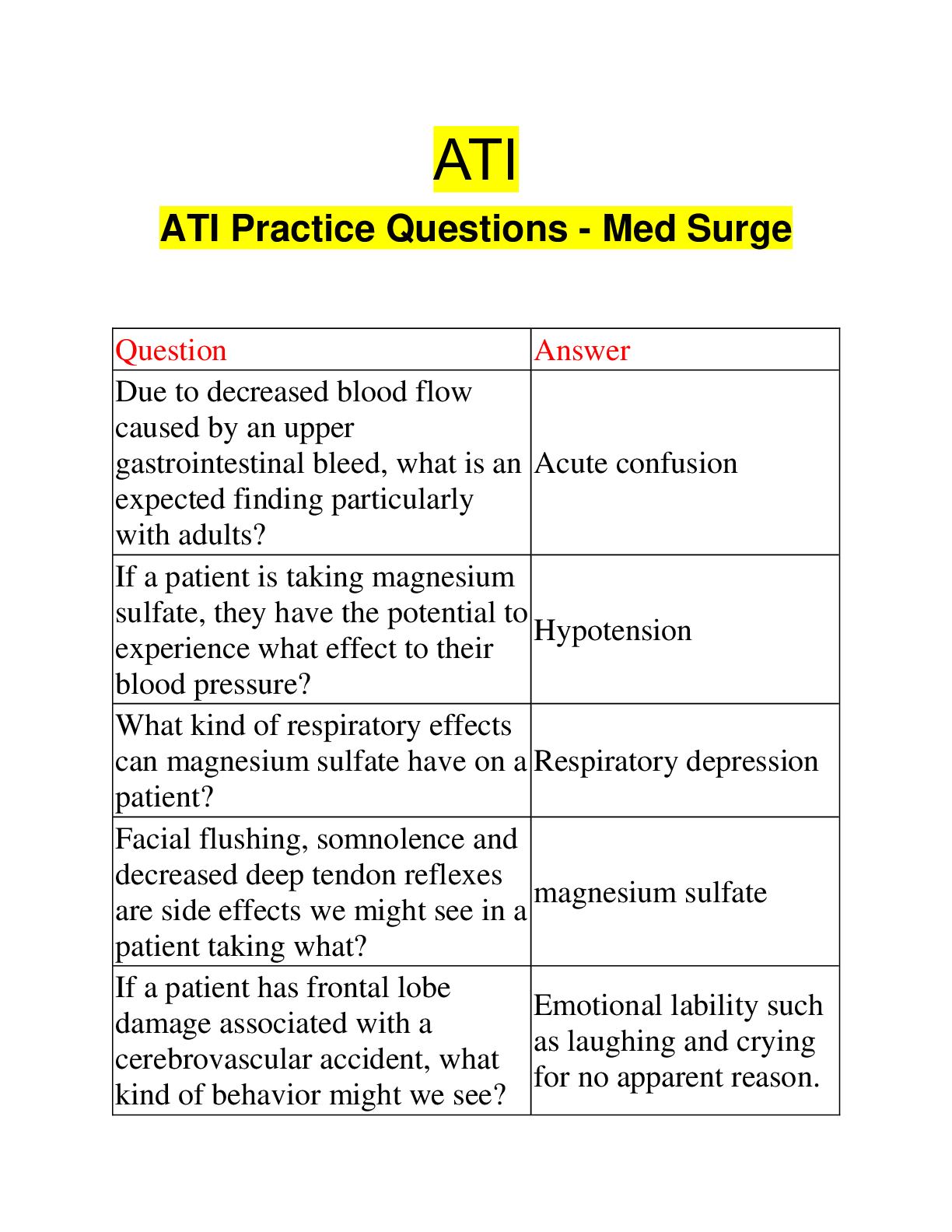NURS 406 - MED SURGE Respiratory ATI 2020.
Document Content and Description Below
NURS 406 MED SURGE Respiratory ATI 1- A charge nurse receives notification of the admission of a client who is coughing frequently and whose sputum is pink, frothy, and copious. The client has histor... y of night sweats, anorexia, and weight loss. Which of the following actions should the nurse take? (SATA) 2- A nurse is assisting a provider with a comprehensive physical examination of a client. When the provider uses transillumination, the nurse should explain to the client that this technique help evaluate which of the following structures? 3- A nurse is caring for a client who smokes cigarettes and has a new diagnosis of emphysema. How should the nurse assist the client with smoking cessation? 4- A nurse is planning care for a client who has chronic obstructive pulmonary disease (COPD) and is malnourished. Which of the following recommendations to promote nutritional intake should the nurse include in the plan? 5- A nurse is preparing to administer cisplatin IV to a client who has lung cancer. The nurse should identify that which of the following findings is an adverse effect of this medication? 6- A nurse in a medical-surgical unit is assessing a client. The nurse should identify that which of the following findings is a manifestation of a pulmonary embolism? 7- A nurse in the PACU is assessing a newly admitted client and observes intercostal retractions and a high-pitched inspiratory sound (stridor). The nurse should identify theses findings as manifestations of which of the following complications? 8- A nurse is reviewing the laboratory results of a client who has metabolic alkalosis. Which of the following laboratory values should the nurse expect? 9- A nurse is providing teaching to a client who has a chronic cough and is scheduled for a bronchoscopy. Which of the following client statements indicates an understanding of the teaching? 10- A nurse is preparing a client for a bronchoscopy. Which of the following actions should the nurse take? (SATA) 11- A nurse is preparing a client for discharge following a bronchoscopy. Which of the following assessment is the nurse’s monitoring priority? 12- A nurse is caring for a client who is postoperative following a thoracic lobectomy. The client has 2 chest tubes in place: 1 in the lower portion of the thorax and the other higher on the chest wall. When a family member asks why the client has 2 chest tubes, which of the following responses should the nurse make? 13- A nurse is providing teaching to a client who will undergo a total laryngectomy. Which of the following statements indicate that the client understands the impact of the surgery? 14- A nurse is providing discharge instructions to a client who has a new laryngectomy. The nurse tells the client to be careful while bathing to prevent which of the following complications? 15- A nurse is caring for a client who is extremely anxious and is hyperventilating. The client’s ABG results are pH 7.50, PaCO2 27 mmHg, and HCO3-25 mEq/L. The nurse should identify that the client has which of the following acid-base imbalances? 16- A nurse is planning postoperative education for a client who will undergo a radical neck dissection for cancer of the larynx. The nurse should include which of the following topics? (SATA) 17- A nurse in a clinic is providing teaching for a client who is scheduled to have a tuberculin skin test. Which of the following pieces of information should the nurse include? 18- A nurse is providing discharge teaching to a client who is postoperative following a rhinoplasty/ Which of the following instructions should the nurse include? 19- A nurse is preparing to assist provider with an arterial blood withdrawal from a client’s radial artery for ABG measurements. Which of the following actions the nurse plan to take? 20- A nurse is providing teaching to a client about pulmonary function testing. Which of the following tests measures the volume of air the lungs can holds at the end of maximum inhalation? 21- A nurse is providing preoperative teaching to a client who is to undergo a pneumonectomy. The client states, “I am afraid coughing will hurt after surgery.” Which of the following statements by the nurse is appropriate? 22- A nurse is caring for a client who has a tracheostomy and is receiving mechanical ventilation. When the low-pressure alarm on the ventilator sounds, it indicates which of the following to the nurse? 23- A nurse is caring for a client who is postoperative following a rhinoplasty. Which of the following findings should the nurse report to the surgeon? 24- A nurse is caring for a client immediately following extubation. Which of the following manifestations indicates that the nurse should call the rapid response team? 25- A nurse is caring for a client who has a chest tube. The nurse notes that the chest tube has become disconnected from the chest drainage system. Which of the following actions should the nurse take? 26- A nurse is caring for a client following a right pleural thoracentesis. The nurse measures a total of 35 ml of purulent drainage. Which of the following findings should the nurse recognize as an indication of tension pneumothorax? (SATA) 27- A nurse is providing discharge teaching to a client who has emphysema. Which of the following instructions should the nurse include? 28- A nurse is caring for a client who had a left lower lobectomy to treat lung cancer. Which of the following factors will have a significant impact on the plan of care for this client? 29- A nurse is assessing a client who has a positive tuberculin skin test. Which of the following findings indicates that the client has active tuberculosis? 30- A nurse is providing discharge teaching to a client who had a pulmonary embolism. Which of the following statements indicates that the client understands the information? 31- A nurse is caring for a client whom the respiratory therapist has just removed the endotracheal tube. Which of the following actions should the nurse take first? 32- A nurse in a provider’s office is assessing a client who states he was recently exposed to tuberculosis. Which of the following findings is a clinical manifestation of pulmonary tuberculosis? 33- A nurse on a medical-surgical unit is caring for a client who is postoperative following a hip replacement surgery. The client reports feeling apprehensive and restless. Which of the following findings should the nurse recognize as an indication of pulmonary embolism? 34- A client is admitted to the emergency department following a motorcycle crash. The nurse notes a crackling sensation upon palpation of the right side of the client’s chest. After notifying the provider, the nurse document this finding as which of the following? 35- A nurse on a medical unit is caring for a client who aspirated gastric contents prior to admission. The nurse administers 100% oxygen by nonrebreather mask after the client reports severe dyspnea. Which of the following findings is a clinical manifestation of acute respiratory distress syndrome (ARDS)? 36- A nurse is caring for an older adult client who has chronic obstructive pulmonary disease (COPD) with pneumonia. The nurse should monitor the client for which of the following acid-base imbalances? 37- A nurse in an urgent care clinic is collecting data from a client who report exposure to anthrax. Which of the following findings is an indication of the prodromal stage of inhalation anthrax? 38- A nurse is caring for a client who has a tracheostomy with an inflated cuff in place. Which of the following findings indicates that the nurse should suction the client airway secretions? 39- A nurse is planning care for a client following placement of a chest tube 1 hr ago. Which of the following actions should the nurse include in the plan of care? 40- A nurse in the emergency department is assessing a client for closed pneumothorax and significant bruising of the left chest following a motor-vehicle crash. The client reports severe left chest pain on inspiration. The nurse should assess the client for which of the following manifestations of pneumothorax? 41- A nurse is providing discharge teaching about improving gas exchange for client who has emphysema. Which of the following instructions should the nurse include in the teaching? 42- A nurse is caring for a client who is scheduled to have his chest tube removed. Which of the following actions the nurse takes? 43- A nurse is caring for a client who is receiving mechanical ventilation and develops acute respiration distress. Which of the following actions should the nurse take first? 44- A client comes to the emergency department in severe respiratory distress following left-sided blunt chest trauma. The nurse notes absent breath sounds on the client’s left side and a tracheal shift to the right. For which of the following procedures should the nurse prepare the client? 45- A nurse a caring for a client who is experiencing acute opioid toxicity. Which of the following actions should the nurse identify as the priority? 46- A nurse on a medical-surgical unit is caring for 4 clients. Which of the following clients should the nurse monitor for crepitus? 47- A nurse is caring for a client with pneumonia who is experiencing thick oral secretions. Which of the following actions should the nurse take first? 48- A nurse is caring for a client who has a chronic obstructive pulmonary disease (COPD) and is experiencing shortness of breath. Which of the following actions should the nurse perform first? 49- A nurse is auscultating the lungs of a client who is having an acute asthma attack. Which of the following sounds should the nurse expect to hear? 50-A nurse is assessing a client who has pharyngitis. Which of the following Is the nurse’s priority to report to the provider? 51-A nurse is providing postoperative care for a client who has 2 chest tubes in place following a lobectomy. The client asks the nurse the reason for having 2 chest tubes. The nurse should inform the client that lower chest tube is placed for which of the following reasons? 52- A nurse is caring for a client who has a 20-year history of COPD and is receiving oxygen at 2 L/min via nasal canula. The client is dyspneic and has an oxygen saturation via pulse oximetry of 85%. Which of the following actions should the nurse take? 53- A nurse is teaching breathing techniques to a client who has emphysema. Which of the following statements indicates that the client understands the mechanics of pursed-lip breathing? 54- A nurse is planning care for a client who is postoperative following a hip arthroplasty. In the client’s medical records, the nurse notes a history of chronic obstructive pulmonary disease (COPD). Which of the following oxygen-delivery methods should the nurse plan to use for this client? 55- A nurse is providing preoperative teaching to a client who has lung cancer and will undergo a pneumonectomy. Which of the following statements should the nurse include? 56- A nurse is providing instructions about pursed-lip breathing for a client who has chronic obstructive pulmonary disease (COPD) with emphysema. This breathing accomplishes which of the following? 57- A nurse is preparing a client for thoracentesis. In which of the following positions should the nurse place the client? 58- A nurse is developing a teaching plan for a client about preventing acute asthma attacks. Which of the following points should the nurse plan to discuss first? 59- A nurse on a medical-surgical unit is assessing a client who recently transferred from the ICU following endotracheal extubation. Which of the following findings should the nurse identify as a possible manifestation of tracheal stenosis and report to the provider? 60- A nurse is teaching a client with cystic fibrosis about daily chest physiotherapy. Which of the following is the purpose of these treatments? 61- A nurse is assessing the respiratory status of a client who has COPD. Which of the following manifestations should the nurse identify as an indication of impending respiratory failure? BOARD VITALS 1- A nurse is reviewing the discharge instruction for a client who is recovering from pneumonia. Which of the following statements should the nurse make? 2- A nurse in an emergency department is assessing a client who has a flail chest from blunt chest trauma. Which of the following findings should the nurse expect: (SATA) 3- A nurse is caring for an adolescent with cystic fibrosis. Which finding requires immediate intervention when caring for this client? 4- A nurse in the emergency department is assessing a client admitted to the emergency department who has sustained crushing chest injuries in a car accident. Which of the following signs indicate a possible pneumothorax? 5- A client who had extensive pelvic surgery 24 hr ago becomes cyanotic, is gasping for breath, and complains of right-sided chest pain. What should the nurse do first? 6- A client is admitted with second degree burns on face, neck, anterior chest, and hands. The nurse’s priority action would be: 7- A client who underwent a left lower lobectomy is forty-eight hrs post op. The client is receiving morphine sulfate via a patient-controlled analgesia (PCA) system and report having pain in the left thorax that worsens coughing. The nurse should: 8- A nurse is caring for a client who is undergoing tracheostomy. The nurse understands that which of the following is a complication of this procedure? 9- A nurse is assessing a client’s arterial blood results. The results are pH 7.50, bicarbonate 32mEq/L, and PaCO2 36 mmHg. Which of the following do these arterial gas results indicate? 10- A nurse is caring for a client on a ventilator who has ventilator settings with a preset tidal volume. Which best describes the tidal volume (VT) in this setting: 11- The nurse is caring for a client who has just been intubated for respiratory failure. The physician orders the ventilator to be set SIMV mode. Which best describes SIMV? 12- A client with asthma is scheduled for treatment with methylxanthine for nocturnal wheezing. Which of the following drugs are methylxanthine drugs that are appropriate for the treatment of this client? (SATA) 13- The nurse is administering cromolyn sodium (Intal) for client with asthma. Which of the following are true about this drug? (SATA) 14- A nurse caring for a client with hemothorax. The physician plans to insert a right-sided chest tube. (La pregunta pide ordenar los cuadritos en el orden correcto) 15- A 33-year-old client is in the ICU for treatment of acute respiratory distress syndrome (ARDS). (la pregunta pide ordenar los pasos para realizar endotraqueal suctioning en orden) 16- The nurse is assessing a client with ARDS (acute respiratory distress syndrome). Which of the following may have caused the client’s condition? (SATA) 17- The nurse is assessing a client with extrapulmonary tuberculosis. Which of the following is true about this type of condition? (SATA) 18- Which of the following devices is most appropriate for delivering a predicted oxygen concentration in a client with unstable chronic obstructive pulmonary disease (COPD)? 19- A nurse is assessing a client with emphysema. Which assessment findings does the nurse anticipate in this form of COPD? (SATA) 20- A nurse is caring for 4 new clients. When receiving reports, the nurse should prioritize assessment of which of the following? 21- A charge nurse is admitting an elderly client with influenza. Which of the following precautions are necessary for preventing the transmission of influenza virus to other clients? (SATA) 22- A nurse is caring for a client with a tracheostomy who is conscious and beginning to advance his oral intake. Which of the following actions should the nurse perform to reduce the risk of aspiration? (SATA) 23-When providing instruction to a client newly diagnosed with asthma concerning the correct use of a corticosteroid inhaler and short-acting beta agonist inhaler (albuterol), which of the following should the nurse relay? 24- A nurse is caring for a client with measles. Which of the following strategies the nurse implements to prevent the spread of infection? 25- A nurse is providing teaching about an ipratropium MDI that was recently prescribed to a client with COPD. Which of the following statements indicates the client needs further teaching about this medication? 26- When caring for a client with hypoxemia and right-sided pneumonia, the nurse knows to place the client in which of the following positions to improve oxygen saturation? 27- What is the priority action when the nurse is changing the ties on a recently placed tracheostomy tube that becomes accidentally dislodged when the client moves suddenly? 28- A nurse is caring for a client with an acute asthma exacerbation who is receiving treatment with nebulized epinephrine. Which of the following is an adverse effect of the medication? 29-A nurse is caring for a 62-y/o client who has been diagnosed with emphysema. The nurse understand that the client is at high-risk for pulmonary infection. Which of the following conditions predisposes the client to infection? 30-Anurse is caring for a client who has an exacerbation of chronic obstructive pulmonary disease (COPD). On assessment, the client has a respiratory rate of 33/min, SaO2 of 85%, shallow respirations with accessory muscles use, and scattered wheezing. The nurse knows that which of the following devices is most appropriate for delivery of supplemental oxygen to this client? 31- A nurse is assisting with the care of a child who is experiencing respiratory failure. Which of the following findings are considered early cardinal manifestations of this condition? (SATA) 31- A nurse is reviewing the discharge instruction for a client who is recovering from pneumonia. Which of the following statements should the nurse make? 32- A nurse is caring for a client who has heart failure and reports increased shortness of breath. After increasing the client’s oxygen, which of the following actions should the nurse take first? 33- A nurse is helping a newly care for a client who has COPD and is receiving mechanical ventilation. Which of the following statements by the newly licensed nurse about pressure support ventilation (PSV) indicates an understanding of the procedure? 34- A nurse in an ICU is caring for a client who has a pulmonary artery catheter and a pressure monitoring system. The client has a central venous pressure (CVP) of 9 mm Hg and a pulmonary artery wedge pressure (PAWP) of 17 mmHg. Which of the following findings should the nurse expect? 35- A nurse is teaching a client who has a new prescription for a metered-dose inhaler (MDI) to treat bronchitis. Which of the following information should the nurse include in the teaching? 36- A nurse is caring for a client who has COPD and requires an oxygen saturation measurement. The nurse observes that the client has edema of both hands and thickened toenails. The nurse should apply the pulse oximeter probe to which of the following locations? 37- A nurse is planning care for a client who has pneumonia and a prescription for oxygen therapy at 5 L/min via nasal cannula. Which of the following interventions should the nurse include in the plan? 38- A nurse is providing teaching to the guardian of a child who has asthma and a new prescription for levalbuterol solution via nebulizer. Which of the following statements by the guardian indicates an understanding of the teaching? 39- A nurse is assessing a client who has a terminal cancer, is unresponsive, and has a respiratory rate of five breaths per minute. The client’s family member requests the client receive morphine for pain. Which of the following ethical principles should the nurse use to support the decision to withhold the medication? 40- A nurse is preparing a plan of care on the admission for a client who has active tuberculosis (TB). Which of the following intervention should the nurse include in the plan? 41- A nurse is caring for a client who is undergoing tracheostomy. Which of the following complications is associated with this procedure? 42- A client experienced onset of shortness of breath after placement of a central venous pressure line is placed in the right subclavian vein. Which of the following supports a diagnosis of pneumothorax? 43- A nurse is caring for a term neonate diagnosed with transient tachypnea at 2 hours after birth. Which if the following interventions is appropriate when caring for this infant? 44- A nurse is providing care to a client who is to be maintained on strict bed rest for three weeks. In order to help prevent atelectasis, the nurse teaches the client to: 45- A nurse is caring for a client who is on a mechanical ventilator and who receives nutrition through a feeding tube. Which position would most likely reduce the risk of this patient developing aspiration pneumonia? 46- A charge nurse in a pediatric unit is giving an Inservice about preventing the transmission of respiratory syncytial virus (RSV). Which of the following should be included in the teaching (SATA)? 47- A nurse in the ED is caring for a child in respiratory distress. Which of the following is the most important initial action by the nurse? 48- A nurse is caring for a client who requires thoracentesis. To best prepare the client for the procedure, what information should the nurse provide? 49-A nurse is preparing to perform endotracheal suctioning for a client who is intubated and mechanically ventilated. Which of the following will the nurse consider when performing this task? 50-A nurse is caring for a client with a chest tube that is connected to a water seal drainage system. What is the purpose of a seal chamber in a chest tube drainage system? 51-A nurse is caring for a client who has a chest tube in place for treatment of hemothorax. Which of the following is appropriate when caring for a client with a chest tube? 52-Which of the following clients are candidates for chest physiotherapy? 53- A nurse is caring for a client who has an upper airway obstruction and an emergency needle cricothyrotomy must be performed. After penetration of the cricothyroid membrane and confirmation of the position of the incision, what is the next step? 54- A nurse is providing bag-mask ventilation for a client with an oropharyngeal airway in place. Which of the following is a contraindication to placement of an oropharyngeal airway? (SATA) 55- A nurse is caring for a client who requires a mechanical ventilator to help with breathing and regular suctioning of secretions to clear the airway. Which of the following intervention should the nurse perform to prevent hypoxemia during suctioning? (SATA) 56- A nurse is caring for an adult client who is being treated for pancreatitis and requires a mechanical ventilator for assistance with breathing. The physician orders an arterial blood gas, which provides the following results: pH: 7.28; Pco2: 51mmHg; HCO3: 24 mEq/L; SaO2: 92%. Based on these results, which of the following best describes this client’s condition? 57- A nurse is caring for a client with severe COPD and pneumonia who is receiving supplemental oxygen at 2 L/min. The client’s respirations are rapid and shallow. Which of the following arterial blood gas values indicate impending respiratory failure? 58- Which of the following methods of oxygen delivery should a nurse use to administer oxygen for a client with a drop in oxygen saturation from 96% to 88% on room air after receiving morphine to relieve pain after colon resection? (The client is resting but remains oriented and can be easily aroused by verbal stimuli) 59- A client with an acute exacerbation of chronic obstructive pulmonary disease (COPD) is oxygenated using a Venturi mask with an FiO2 of 40%. Arterial blood gas measurement reveals Pao2 70 mmHg and PaCO2 75 mmHg. Which of the following orders does the nurse anticipate from the healthcare provider? 60- Which of the following would a nurse expect on assessment of a client with fat embolism syndrome after femur fracture? (SATA) 61- A nurse is teaching a client with asthma about his new medications, which include an albuterol inhaler (bronchodilator) prescribed 2 puff every 4 hours as needed and inhaled triamcinolone, a corticosteroid, 2 puff twice daily. Which of the following is most important to prioritize when teaching this client? 62-Anurse is caring for a client with a chest tube for pneumothorax. A family member trips on the tubing and pulls the chest tube out. The client’s heart rate increases to 140/min, and his oxygen saturation drops to 88%. There is an audible leak at the insertion site. What should the nurse do immediately? 63- A nurse is caring for a client with COPD newly admitted after a hip replacement surgery. The client has a prescription for supplemental oxygen by Venturi mask at FiO2 of 60% and flow rate of 8L/min. Which of the following is the appropriate action by the nurse? 64- A nurse is providing education for a client concerning a new prescription for tiotropium for COPD. Which of the following statements indicates the client has understood the nurse’s teaching? 65- A nurse in the ICU is providing teaching to a student nurse before ventilator support is withdrawn from a client with multi-system organ failure. The nurse should relay which of the following while providing education to the student nurse concerning care of a client after withdrawal of life support? 66- A nurse is caring for a 26 y/o female client with a recent history of international travel, fever, and suspected H1N1 infection. The nurse understands that which of the following symptoms are consistent with H1N1 infection? (SATA) 67- A nurse is teaching a newly licensed nurse about the purpose of administering vecuronium to a client who has acute respiratory distress (ARDS). The nurse should identify that which of the following statements by the newly licensed nurse indicates an understanding of the teaching? 68- A nurse is caring for a client who has acute respiratory distress syndrome (ARDS) and is being mechanical ventilated. The client is prescribed vecuronium. Which of the following medications should the nurse anticipate administering with this medication? (SATA) 69-A nurse is completing the admission assessment on a client who has suspected lung cancer. Which of the following manifestations should the nurse expect? (SATA) 70- A nurse is assessing a client who has COPD and limited mobility. For which of the following physiological responses to prolonged immobility should the nurse assess the client? 71- A nurse is demonstrating diaphragmatic breathing to a group of clients who are scheduled for surgery. Which of the following actions should the nurse include in the demonstration? 72- The nurse is caring for a client admitted with a diagnosis of pneumonia. What is the most appropriate nursing diagnosis for this client? 73- A nurse is caring for a client with COPD. Which clinical finding supports the nurse’s suspicion that the client is developing cor pulmonale? 74- A client with pneumonia is complaining of difficulty breathing. Which of the following interventions is appropriate for this type of client? (SATA) 75- A nurse is planning care for a client who has severe acute respiratory syndrome (SARS). Which of the following interventions should the nurse include in the plan? (SATA) 76- A nurse is performing an indirect fist percussion on the back of a client. Put the following steps of this process in order. 77- The nurse is caring for a client admitted with an acute upper respiratory infection and has a productive cough. What is the most appropriate nursing diagnosis for this client? 78- A home health nurse is helping a client who uses oxygen at home. Which of the following instructions should the be included as part of teaching for this client, to keep him safe around oxygen? (SATA) 79- When administering IV morphine every 3-4 hours as needed for postoperative pain, the nurse knows to implement which of the following interventions? (SATA) 80- The nurse receives a prescription of cefazolin (Ancef) IV piggyback for a client with an upper respiratory infection. Which are the appropriate nursing interventions? (SATA) 81- A nurse is caring for a client who remains intubated after receiving a procedure performed under general anesthesia. The nurse understands that extubation will occur when which of the following happens? 82- A nurse is assessing a 70 y/o male client who was recently admitted with an exacerbation of chronic obstructive pulmonary disease (COPD). His oxygen saturation is 83%, on 2 L by Venturi mask. His respiratory rate is 10/min and he appear sedated. Which of the following medications prescribed for this client should concern the nurse? 83- A nurse is assessing a client for tactile fremitus. The nurse does which of the following while performing this part of the exam? 84- A nurse is assigning client care tasks to an LPN. Which of the following tasks is most appropriate to assign for a client with COPD and a nursing diagnosis of ineffective breathing pattern? 85- A client has just returned from the post-anesthesia care units having a laryngectomy. Which of the following interventions should the nurse include in the plan of care? 86- A nurse is caring for a client who requires mechanical ventilation for respiratory failure. Which of the following may have caused the client’s condition? (SATA) 87- A nurse in a pediatric unit is teaching a group of students about childhood diseases that are associated with pneumonia. Which of the following disease can result in pneumonia? 9SATA) [Show More]
Last updated: 2 years ago
Preview 1 out of 31 pages
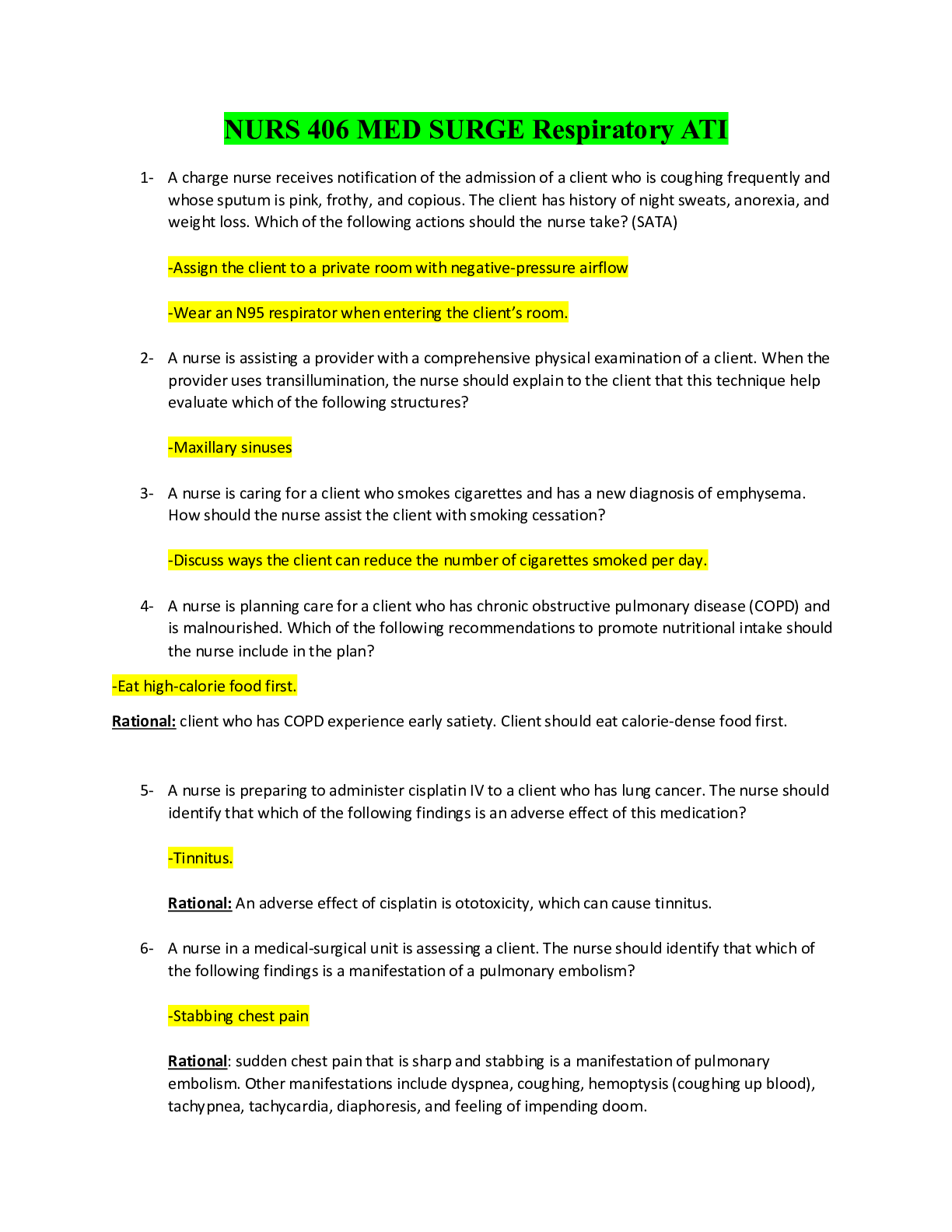
Buy this document to get the full access instantly
Instant Download Access after purchase
Buy NowInstant download
We Accept:

Also available in bundle (2)

NURS 406 Capstone Mental Health Assessment,NURS 406 - ASSESSMENT LEADERSHIP AND COMMUNITY HEALTH,NURS 406 - MED SURGE Respiratory ATI 2020,NURS 406 - PHARMACOLOGY ASSESSMENT 1& 2,NURS 406 -Maternal Newborn Assessment,NURS 406 - NCLEX LIVE-REVIEW QUESTIONS & ANSWERS,NURS 406 -Assessment Quiz - Nursing Care of Children
NURS 406 Capstone Mental Health Assessment,NURS 406 - ASSESSMENT LEADERSHIP AND COMMUNITY HEALTH,NURS 406 - MED SURGE Respiratory ATI 2020,NURS 406 - PHARMACOLOGY ASSESSMENT 1& 2,NURS 406 -Maternal Ne...
By Ajay25 4 years ago
$50
7

NURS 406 Capstone Mental Health Assessment,NURS 406 - ASSESSMENT LEADERSHIP AND COMMUNITY HEALTH,NURS 406 - MED SURGE Respiratory ATI 2020,NURS 406 - PHARMACOLOGY ASSESSMENT 1& 2,NURS 406 -Maternal Newborn Assessment,NURS 406 - NCLEX LIVE-REVIEW QUESTIONS & ANSWERS,NURS 406 -Assessment Quiz - Nursing Care of Children
NURS 406 Capstone Mental Health Assessment,NURS 406 - ASSESSMENT LEADERSHIP AND COMMUNITY HEALTH,NURS 406 - MED SURGE Respiratory ATI 2020,NURS 406 - PHARMACOLOGY ASSESSMENT 1& 2,NURS 406 -Maternal Ne...
By Ajay25 4 years ago
$42
7
Reviews( 0 )
$13.50
Can't find what you want? Try our AI powered Search
Document information
Connected school, study & course
About the document
Uploaded On
Jan 02, 2021
Number of pages
31
Written in
Additional information
This document has been written for:
Uploaded
Jan 02, 2021
Downloads
0
Views
342

